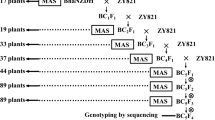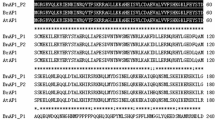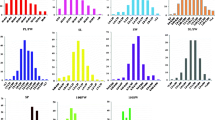Abstract
The inheritance of yield-related traits in rapeseed (Brassica napus) is poorly understood, and the investigations on mapping of quantitative trait loci (QTL) for such traits are only few. QTL related to six traits were mapped which include plant height (PH), height of lowest primary effective branch (HPB), length of main inflorescence (LMI), silique length (SL), number of primary branches (FB) and silique density (SD). A set of 258 doubled haploid (DH) lines derivatives of a cross between a canola variety Quantum and a resynthesized B. napus line No.2127-17, and a fixed immortalized F2 (designated as IF2) population generated by randomly permutated intermating of these DHs were investigated. A genetic linkage map was constructed using 208 SSR and 189 SRAP markers for the DH population. Phenotypic data were collected from three environments for the two populations. Using composite interval mapping analyses, 30 and 22 significant QTL were repeatedly detected across environments for the six traits in the DH and IF2 populations, respectively. Twenty-nine QTL were common between the two populations. The directions of parental contribution for all common QTL were the same, showing a great potential for marker-assisted selection in improving these traits. Some chromosomal regions harbor QTL for multiple traits, which were consistent with significant phenotypic correlations observed among traits. The results provided a better understanding of the genetic factors controlling yield-related traits in rapeseed.


Similar content being viewed by others
References
Butruille DV, Guries RP, Osborn TC (1999) Linkage analysis of molecular markers and quantitative trait loci in populations of inbred backcross lines of Brassica napus L. Genetics 153:949–964
Delourme R, Falentin C, Huteau V, Clouet V, Horvais R, Gandon B, Specel S, Hanneton L, Dheu JE, Deschamps M, Margale E, Vincourt P, Renard M (2006) Genetic control of oil content in oilseed rape (Brassica napus L.). Theor Appl Genet 113:1331–1345
Doerge RW, Churchill GA (1996) Permutation tests for multiple loci affecting a quantitative character. Genetics 142:285–294
Dreyer F, Graichen K, Jung C (2001) A major quantitative trait locus for resistance to Turnip Yellows Virus (TuYV, syn. beet western yellows virus, BWYV) in rapeseed. Plant Breed 120:457–462
Ferreira ME, Satagopan J, Yandell BS, Williams PH, Osborn TC (1995) Mapping loci controlling vernalization requirement and Xowering time in Brassica napus. Theor Appl Genet 90:727–732
Howell PM, Sharpe AG, Lydiate DJ (2003) Homoeologous loci control the accumulation of seed glucosinolates in oilseed rape (Brassica napus). Genome 46:454–460
Hua JP, Xing YZ, Xu CG, Sun XL, Yu SB, Zhang QF (2002) Genetic dissection of an elite rice hybrid revealed that heterozygotes are not always advantageous for performance. Genetics 162:1885–1895
Kosambi DD (1944) The estimation of map distances from recombination values. Ann Eugen 12:172–175
Lander ES, Botstein D (1989) Mapping mendelian factors underlying quantitative traits using RFLP linkage maps. Genetics 121:185–199
Lander ES, Green P, Abrahamson J, Barlow A, Daly MJ, Lincoln SE, Newburg I (1987) MAPMAKER: an interactive computer package for constructing primary genetic linkage maps of experimental and natural populations. Genomics 1:174–181
Li G, Quiros CF (2001) Sequence-related amplified polymorphism SRAP a new marker system based on a simple, PCR reaction: its application to mapping, and gene tagging in Brassica. Theor Appl Genet 103:455–461
Liu XP, Tu J, Chen B, Fu T (2005) Identification and inheritance of a partially dominant gene for yellow seed colour in Brassica napus. Plant Breed 124:9–12
Lowe AJ, Moule C, Trick M, Edwards KJ (2004) Efficient large-scale development of microsatellites for marker and mapping applications in Brassica crop species. Theor Appl Genet 108:1103–1112
Marwede V, Gul MK, Becker HC, Ecke W (2005) Mapping of QTL controlling tocopherol content in winter oilseed rape. Plant Breed 124:20–26
Osborn TC, Kole C, Parkin IAP, Kuiper M, Lydiate DJ, Trick M (1997) Comparison of flowering time genes in Brassica rapa, B. napus, and Arabidopsis thaliana. Genetics 146:1123–1129
Parkin IAP, Sharpe AG, Keith DJ, Lydiate DJ (1995) Identification of A and C genomes of amphidiploid Brassica napus (oilseed rape). Genome 38:1122–1131
Parkin IAP, Gulden SM, Sharpe AG, Lukens L, Trick M et al. (2005) Segmental structure of the Brassica napus genome based on comparative analysis with Arabidopsis thaliana. Genetics 171:765–781
Piquemal J, Cinquin E, Couton F, Rondeau C, Seignoret E,Doucet I, Perret D, Villeger MJ, Vincourt P, Blanchard P (2005) Construction of an oilseed rape (Brassica napus L.) genetic map with SSR markers. Theor Appl Genet 111:1514–1523
Qiu D, Morgan C, Shi J, Long Y, Liu J, Li R, Zhuang X, Wang Y, Tan X, Dietrich E, Weihmann T, Everett C, Vanstraelen S, Beckett P, Fraser F, Trick M, Barnes S, Wilmer J, Schmidt R, Li j, Li D, Meng J, Bancroft I (2006) A comparative linkage map of oilseed rape and its use for QTL analysis of seed oil and erucic acid content. Theor Appl Genet 114:67–80
Quijada PA, Udall JA, Lambert B, Osborn TC (2006) Identification of genomic regions from winter germplasm that affect seed yield and other complex traits in hybrid spring rapeseed (Brassica napus L.). Theor Appl Genet 113:549–561
SAS Institute Inc. (1999) SAS user’s guide, release 8.01 edition. SAS Institute Inc., Cary
Song KM, Osborn TC (1992) Polyphyletic origins of Brassica napus—new evidence based on organelle and nuclear RFLP analyses. Genome 35:992–1001
U N (1935) Genome analysis in Brassica with special reference to the experimental formation of B. napus and peculiar mode of fertilization. Jpn J Bot 7:384–452
Udall JA, Quijada PA, Lambert B, Osborn TC (2006) Identification of alleles from unadapted germplasm affecting seed yield and other quantitative traits in hybrid spring oilseed Brassica napus L. Theor Appl Genet 113:597–609
Wang S, Basten CJ, Zeng ZB (2003) Windows QTL Cartographer 2.0. Department of Statistics, North Carolina State University, Raleigh
Yi B, Chen W, Ma C, Fu T, Tu J (2006) Mapping of quantitative trait loci for yield and yield components in Brassica napus L. Acta Agron Sin 32:676–682
Zhao JY, Becker HC, Zhang D, Zhang Y, Ecke W (2006) Conditional QTL mapping of oil content in rapeseed with respect to protein content and traits related to plant development and grain yield. Theor Appl Genet 113:33–38
Acknowledgments
This research was supported by grants from the National Key Basic Research Special Foundation of China (2001CB1088), and Program for Changjiang Scholars and Innovative Research Team in University (IRT0442).
Author information
Authors and Affiliations
Corresponding author
Additional information
Communicated by C. F. Quiros.
Electronic supplementary material
Below is the link to the electronic supplementary material.
Rights and permissions
About this article
Cite this article
Chen, W., Zhang, Y., Liu, X. et al. Detection of QTL for six yield-related traits in oilseed rape (Brassica napus) using DH and immortalized F2 populations. Theor Appl Genet 115, 849–858 (2007). https://doi.org/10.1007/s00122-007-0613-2
Received:
Accepted:
Published:
Issue Date:
DOI: https://doi.org/10.1007/s00122-007-0613-2




